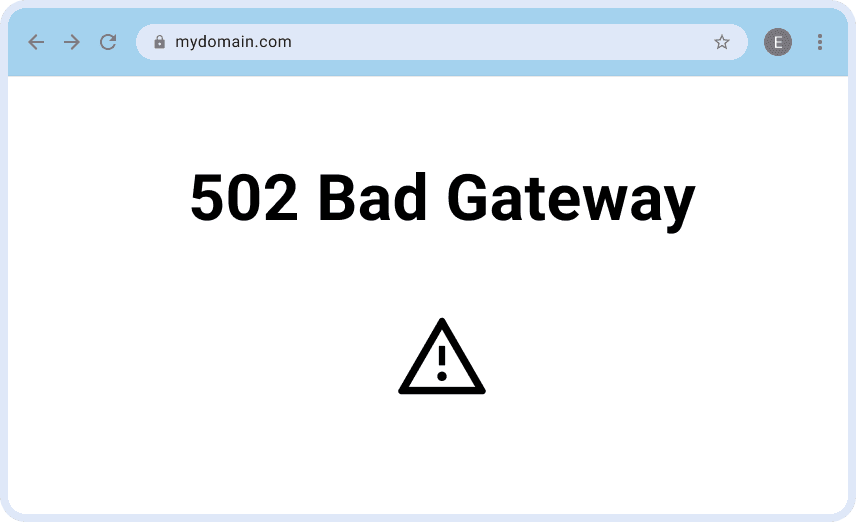Have you ever tried to visit a website only to be greeted by a frustrating error message that says "502 Bad Gateway"? If so, you're not alone. This common web error can be confusing and annoying, especially if you don't know what it means or how to fix it. In this article, we'll break down everything you need to know about the 502 Bad Gateway error in simple terms. We'll explain what it is, why it happens, and most importantly, how to solve it.

What is a 502 Bad Gateway Error?
Let's start with the basics. A 502 Bad Gateway error is a type of HTTP status code. HTTP status codes are like short messages that websites use to tell your browser what's happening when you try to visit a page. When you see a 502 Bad Gateway error, it means that one server (called a gateway or proxy) tried to get information from another server but received an invalid response.
To put it in everyday terms, imagine you're at a restaurant, and you ask the waiter to bring you a menu. The waiter (like the gateway server) goes to the kitchen (like the upstream server) to get the menu. But instead of bringing back a menu, the waiter returns with a blank piece of paper. That's kind of what a 502 Bad Gateway error is like – the gateway server couldn't get the right information it needed from another server.
Why Does a 502 Bad Gateway Error Occur?
There are several reasons why you might encounter a 502 Bad Gateway error. Let's look at some of the most common causes:
- Server Overload: Sometimes, websites get too many visitors at once, and the server can't handle all the requests. It's like too many people trying to squeeze through a single door at the same time.
- Network Issues: Problems with the internet connection between servers can cause this error. It's similar to trying to make a phone call, but the line is busy or disconnected.
- Server Software Problems: The software running on the server might have bugs or configuration issues. This is like having a faulty cash register at a store – it prevents normal operations.
- Firewall Blocks: Sometimes, security measures like firewalls can accidentally block valid traffic. It's like a bouncer at a club who's being too strict and not letting the right people in.
- Slow Response from Upstream Servers: If the main server is taking too long to respond, the gateway might give up waiting. This is like standing in a long line at a store and deciding to leave because it's taking too long.
- DNS Issues: Problems with the Domain Name System (DNS) can also cause 502 errors. DNS is like the phone book of the internet, and if it's not working correctly, servers can't find each other.
How to Fix a 502 Bad Gateway Error?
Now that we understand what causes this error, let's talk about how to fix it. We'll divide the solutions into two parts: what you can do as a website visitor, and what website owners or administrators can do.
For Website Visitors:
- Refresh the Page: Sometimes, the error is temporary. Wait a few seconds and try refreshing the page. It's like trying to open a stuck door – sometimes a second push does the trick.
- Clear Your Browser Cache: Your browser saves information to load pages faster, but sometimes this saved data can cause problems. Clearing your cache is like giving your browser a fresh start.
- Try a Different Browser: If the error persists, try opening the website in a different browser. This helps determine if the problem is with your browser or the website itself.
- Check If the Site Is Down for Everyone: Use websites like "Down for Everyone or Just Me" to see if others are having the same problem. If it's down for everyone, the issue is likely on the website's end.
- Restart Your Devices: Turn off your computer and router, wait for a minute, and turn them back on. This can sometimes resolve network-related issues.
- Contact Your Internet Service Provider: If you're having trouble accessing multiple websites, the problem might be with your internet connection. Reaching out to your ISP can help identify any network issues.
For Website Owners and Administrators:
- Check Server Resources: Make sure your server isn't overloaded. You might need to upgrade your hosting plan or optimize your website to handle more traffic.
- Review Server Logs: Look for any error messages or unusual activity in your server logs. This can help pinpoint the exact cause of the problem.
- Check Your Web Server Configuration: Ensure that your web server software (like Apache or Nginx) is configured correctly. Sometimes, simple misconfigurations can cause 502 errors.
- Temporarily Disable CDN or Firewall: If you're using a Content Delivery Network (CDN) or firewall, try disabling them temporarily to see if they're causing the issue.
- Update Server Software: Make sure all your server software is up to date. Outdated software can sometimes cause compatibility issues leading to 502 errors.
- Check for Code Errors: If you've recently made changes to your website's code, review these changes. A simple coding error can sometimes cause server issues.
- Contact Your Hosting Provider: If you've tried everything and still can't resolve the issue, reach out to your hosting provider. They may be able to identify server-side problems that you can't see.
How to Prevent 502 Bad Gateway Errors?
While it's not always possible to prevent 502 errors completely, there are steps you can take to reduce their occurrence:
- Regular Maintenance: Keep your server software and website code up to date.
- Monitor Server Health: Use tools to keep an eye on your server's performance and resource usage.
- Optimize Your Website: Reduce the load on your server by optimizing images, using caching, and minimizing plugins.
- Use a Reliable Hosting Provider: Choose a hosting service known for its reliability and good customer support.
- Implement Load Balancing: For high-traffic websites, consider using multiple servers to distribute the load.
Understanding Error Variations
It's worth noting that you might see variations of the 502 Bad Gateway error. Some common ones include:
- "502 Service Temporarily Overloaded"
- "HTTP 502"
- "502 Proxy Error"
- "502 Server Error: The server encountered a temporary error and could not complete your request"
These all essentially mean the same thing – there's a problem with the communication between servers.
Conclusion
The 502 Bad Gateway error can be frustrating, but understanding what it means and how to address it can save you a lot of headaches. Remember, in most cases, it's a temporary issue that can be resolved quickly. For website visitors, simple steps like refreshing the page or clearing your browser cache can often do the trick. For website owners, regular maintenance and monitoring of your server's health are key to preventing these errors.
By following the tips and solutions provided in this guide, you'll be better equipped to handle 502 Bad Gateway errors when they occur. Whether you're a casual internet user or a website administrator, knowing how to troubleshoot this common error will help ensure a smoother, more enjoyable web browsing experience.
Remember, the internet is a complex network of interconnected servers and systems. Sometimes things go wrong, but with a little patience and know-how, most issues can be resolved. Stay curious, keep learning, and don't let error messages discourage you from exploring the vast world of the web!
FAQs
Q1: What is a 502 Bad Gateway error?
A1: A 502 Bad Gateway error occurs when a web server acting as a gateway or proxy receives an invalid response from an upstream server. It indicates a communication problem between servers.
Q2: What are the common causes of a 502 Bad Gateway error?
A2: Common causes include server overload, network issues, misconfigured proxy settings, or problems with the website's coding. It can also occur due to connection timeouts between servers.
Q3: How can I fix a 502 Bad Gateway error as a website visitor?
A3: As a visitor, you can try refreshing the page, clearing your browser cache, or attempting to access the site later. If the problem persists, it's likely a server-side issue that needs to be addressed by the website administrators.
Q4: Is a 502 Bad Gateway error always the website's fault?
A4: Not necessarily. While it's often a server-side issue, it can sometimes be caused by problems on the user's end, such as network connectivity issues or incorrect proxy settings.
Q5: How long does it typically take to resolve a 502 Bad Gateway error?
A5: The resolution time can vary greatly depending on the cause. Some issues may resolve themselves quickly, while others might require intervention from the website's technical team, which could take hours or even days.
About Us
Tencent EdgeOne provides an acceleration and security solution based on Tencent edge nodes to safeguard diverse industries such as e-commerce, retail, finance service, content and news, and gaming and improve their user experience. We have now launched a Free Trial, welcome to Sign Up or Contact Us for more information.

